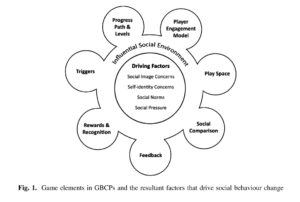Gaming as a driver for social behaviour change for sustainability
Gamified Behaviour Change
‘Gamified Behaviour Change Programmes (GBCPs) are one example of such a social behaviour change intervention, making use of elements of game mechanics to engage the participants in a common objective and stimulate them to adopt sustainable actions under the influence of the social game. Gaming plays a vital role in these programmes as it adds fun and excitement to the process, makes the players compete, either individually or in teams, and stimulates them to perform a range of sustainable actions in a playful way. (…) GBCPs target the social and systemic nature of behaviour by providing an influential social environment for learning and practising sustainable actions that eventually replace (unsustainable) habitual behaviour over time. Through social games, GBCPs encourage the participants to perform the desired behaviour consistently, which eventually establishes social norms and a culture of sustainability within the social group. ‘ (p.259)
Game Elements:
- Play Space (virtual + real)
- Progress Path and Levels (goals, small steps)
- Player Engagement Model (competition, collaboration)
- Triggers (reminders, alerts and prompts)
- Rewards and Recognition (symbolic, economic)
- Feedback (data-based, post-performace)
- Social Comparison
Social Comparison
‘Social comparison refers to the comparison of performances of the participants and the teams. Social comparison was observed as one of the most essential activities because social standing was just as important to people as their individual achievements. When performance was compared, it sparked social image concerns, which led to social pressure (peer pressure). It also intensified competition, which prompted the participants to learn and perform sustainable actions. Comparison implicitly communicated the expected behaviour (social norms), which generated social pressure and encouraged the participants to perform well in order to comply with the social norms.’ (p.264)

